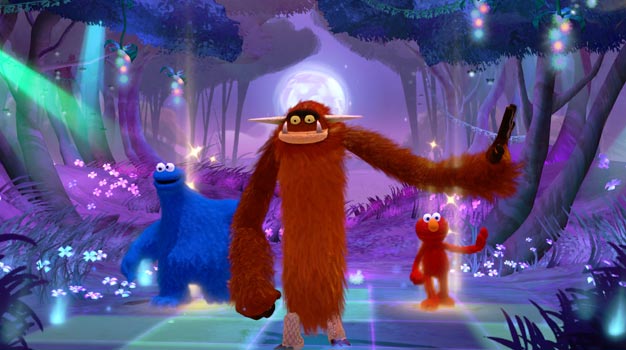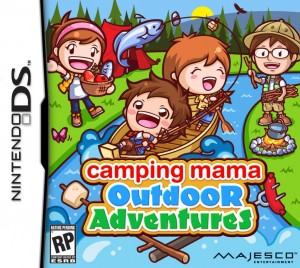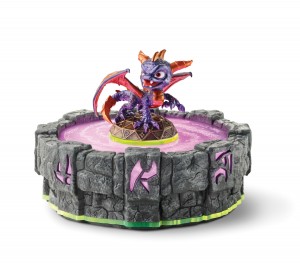The Gamer Parent’s Guide To Gaming
 Last year I did a piece titled “A Parent’s Guide To Video Games For Your Kids”, to help parents determine what kinds of games are appropriate for their little gamers. But what about those parents who are gamers themselves? What kinds of games should they grab to play alongside their gaming progeny? How do you find balance between what Dad or Mom wants to play versus what your young ones should be exposed to? Well, with a little help from a panel of pros at FamilyFriendlyVideogames.com, we explore these questions, and have the answers for you!
Last year I did a piece titled “A Parent’s Guide To Video Games For Your Kids”, to help parents determine what kinds of games are appropriate for their little gamers. But what about those parents who are gamers themselves? What kinds of games should they grab to play alongside their gaming progeny? How do you find balance between what Dad or Mom wants to play versus what your young ones should be exposed to? Well, with a little help from a panel of pros at FamilyFriendlyVideogames.com, we explore these questions, and have the answers for you!
I took the opportunity to correspond with Johner Riehl (Founder and Editorial Director of FamilyFriendlyVideoGames.com), Andy Robertson (known to some as GeekDadGamerfounder, of www.GamePeople.co.uk, host of the Family Gamer TV web series), Mary Heston (of www.MrsVideoGame.com and author of the Kindle books “Violent Games – Violent Children?” and “”Screen Time!” which review the current research on video games and their effect on kids), and Jeff Peeters (Managing Editor at GamerPops.com). We discussed the importance of finding balance between being a gamer and a parent, and the impact and importance of the Entertainment Software Ratings Board (ESRB). Here’s what we’ve got:
W75: Many of us gamers are now older with children of our own, but we still enjoy playing those Mature rated games that may not be appropriate for our little ones. How do you find the balance in time for what Mommy/Daddy wants to play?
Andy Robertson: Our family time on the weekend is spent on games we can play together. This doesn’t mean you have to rule out hardcore games though. A recent favourite in our household (kids 4, 6, 8 ) is playing Wipeout HD on the PS3. It’s a surprisingly good fit for family gamers, and epitomises a more intelligent broadening of gaming’s audience. Turn up the steer assist and use the Sixaxis motion controls and really young players can play too, and in split screen mode with siblings and parents.
There are some games that I save to play in the evening, Uncharted 3 and the like, but even here I find myself drawn to local multiplayer games more since being a parent.
Mary Heston: We have a family game night where we take turns picking out what game we are going to play. Some nights its (sic) the youngest’s choice other nights it’s Dad’s choice. Some nights we play Mario other nights Wii tennis. Just like any R rated movie we might want to watch, we wait to play the M rated games until younger kids are in bed.
Jeff Peeters: Given that we have limited hours in any given week to play games, the split is actually fairly easy to pull off. During the day, Teen and Mature games stay on the shelf. In our house, we also have two separate gaming areas. The kids area has the Wii and an Xbox 360 with Kinect using parental controls to only allow E and E10+ games to be played on it. Daddy’s area has the PS3 and another Xbox 360. This really helps keep thing separate, I find. Once everyone’s in bed or out of the house, and if I have time, then the more “grown up” stuff comes out.
 W75: As we all know, the ESRB makes a great effort to get the information out there that parents need to make informed decisions regarding what games are appropriate for their children. What improvements have you seen in regards to this? What could the ESRB improve on?
W75: As we all know, the ESRB makes a great effort to get the information out there that parents need to make informed decisions regarding what games are appropriate for their children. What improvements have you seen in regards to this? What could the ESRB improve on?
Johner Riehl: The ESRB not only provides great information, but they have worked to make it really easy for parents using today’s technology. Their smartphone app makes it as simple as taking a picture of the box to get ratings information. Even the ESRB will admit, however, that they can only provide part of the answer for parents. They can’t make any judgment about whether or not a game is fun. But that’s why we want parents to know that resources like ours are available, looking at games from a family perspective.
Andy Robertson: The ESRB have done a great job at fleshing out what their rating mean and how they arrived at this decision. Visiting their site and searching for a game will give you a lot more background on the content it contains. Compared the PEGI in Europe they are really leading the way with information the parents need.
I think they could still improve by offering more anecdotal feedback from real parents. Perhaps adding more community features around their core of information –- but then I guess that’s what sites like ours are going.
Mary Heston: We love taking the ESRB with us on the road – We have the ESRB app on our smart phones and we can pull up great information right in the store before making any last minute purchasing decisions.
Jeff Peeters: The ESRB has done a great job in developing more tools for parents to use. Their website is a go-to reference for us, and the mobile apps are especially handy when you’re out looking in stores at a game, especially when it’s a T game, which we find has a large spectrum of appropriateness. The content descriptors and summary are invaluable in determining if that Teen rating is closer to E10+ or Mature. And that’s one thing maybe the ESRB can improve on. Whereas E, E10+, and M are fairly consistent, a breakup of the T category would be nice. Super Smash Bros. Brawl and inFAMOUS 2 have the same T rating for various reasons, but they’re totally different in terms of content and how appropriate they are for younger gamers.
W75: How often do you play games with your children? What games are your favorites to play with them?
Johner Riehl: Our family has a regular time where we play together about once a week, and we love games that let us cooperate. We’ll still play New Super Mario Bros. from time to time, but also greatly enjoy playing the new wave of Kinect games that get us jumping up, down and all around together.
Andy Robertson: We only play on non-school nights, mainly weekends. We play in hour long sessions perhaps two times a day. This adds up to around 4-5 hours a week.
Recently we’ve really enjoyed Driver San Francisco. It’s great the way very young players can help the family play by setting traps for the criminals by connecting the DS to the Wii game. Two older players can control the driving and targeting on the Wii in an experience that enables the toddlers to get in on the action.
Also Fruit Ninja has been popular on Kinect. The simple premise of slicing up fruit with your hands a[nd] feet makes this easy enough for very young players. Add to this the ability for parents and infants to play together and the iPad/iPhone classic game works great on the 360 hands-free Kinect controller.
Mary Heston: We love playing video games together. Of course, the kids seem to be hard wired with knowledge of how to play these games and so sometimes “Playing” together just means sitting there with them while they play. But that still counts. We love playing anything Mario or anything with Dance Dance in the title. Now that the kids are teens now we have just started playing Batman Arkham City which everyone is loving. But just like any activity we work on making sure that there is a balance between video games, regular exercise, school work, and spending time unplugged from it all too. You can’t have a diet of just grapes – grapes are great food but you won’t get all the vitamins and protein you need from just eating grapes. Its (sic) important to have a balance when playing video games too.
Jeff Peeters: We’ll play together 1-3 times a week, depending on available time, and if a game came out recently. Some of our favourites are the LEGO games, since they have a sense of humour and co-operative multiplayer. The recent Kirby games for the Wii (Epic Yarn and Return to Dream Land) have been huge hits in our house as well. Most Mario stuff also goes over well, and Mario Kart Wii was on heavy rotation for a while there.
 W75: As a gaming parent, do you help inform other parents about the ESRB ratings? What kind of feedback do you get?
W75: As a gaming parent, do you help inform other parents about the ESRB ratings? What kind of feedback do you get?
Johner Riehl: Most parents we speak with are familiar with ESRB ratings, but don’t understand the full details about how they are determined. Parents love having more information.
Andy Robertson: When I send parents to the ESRB or PEGI ratings they are usually surprised at how much great information there is.
I recently dedicated one of my Family Gamer TV shows I run for Wired about “How to read a videogame box”. It sounds like a no-brainer. But it’s more complex that you realise – all that information. The response to the show from parents was really positive as you can see in the comments:
Mary Heston: ALL the time. My kids count on other parents using the ESRB guidelines. My older boys hate it when they get online to play an M rated game and there are little kids on there playing. They also hate when parents
complain about these games because the games don’t just magically get into their house. The rating is right on the game.
Its a real mix of responses from other parents. Some parents I talk to are totally dialed in and watch the ratings, play the games with their kids, and enter the family settings into the game systems before even playing. Other parents think that video games are just “games” and since games are for kids they don’t really even think about the fact that some of these games are really developed for an older gamer.
Some parents just abdicate their parenting responsibilities when it comes to gaming because they think somehow the kids understand all this gaming business and since they have raised good kids its (sic) really no big deal.
But even if you have a good kid you still can pick out games that work for you and your family.
Jeff Peeters: Every chance we get. There are so many tools out there to help parents that would take them less than five minutes to find. We’ll tell them about the ESRB, our site, our partner sites in Family Video Game Month, even Metacritic if need be. We’ll explain the system to anybody who will listen and why it’s important for them to understand it. We’re about good gaming and good parenting, and we feel that with all the tools out there, there’s no reason why a parent shouldn’t know that Call of Duty isn’t appropriate for their nine year old. When people see what’s out there, they’re amazed at the resources available. My eight year old son has had the ratings down cold for the last couple of years.
 W75: Do you feel that all of the console makers have a good balance of games for adults as well as games for our children? Are there any consoles that could improve on their balance?
W75: Do you feel that all of the console makers have a good balance of games for adults as well as games for our children? Are there any consoles that could improve on their balance?
Johner Riehl: Although much fanfare and marketing budgets are dedicated to promoting the “AAA” M-Rated blockbusters by most video game publishers, the truth is there are a good amount of family-friendly options on Wii, Xbox 360 and PlayStation move. I’m not sure that you need to make less of one to make more of the other, but we’d obviously like to see family gametime highlighted even more.
Andy Robertson: Because of the financial implications most console makers are doing a pretty good job. I’d like to see Sony follow through with more games for Move, and more games for very young players. I’d also like to see Nintendo do a better job of communicated the advantages of the 3DS over the DS.
Mary Heston: Do you feel that all of the console makers have a good balance of games for adults as well as games for our children? Are there any consoles that could improve on their balance?
We have come a long way from the early days of gaming. Our family got into gaming when there was there were not as many choices. The Nintendo game cube basically only had family friendly games available. When the Xbox first came out and started introducing more adult games it was easy for us to stay with our Nintendo systems and just keep playing the kids games.
Today console makers must have an assortment of games for every type / age of gamer if they want to stay in the game (so to speak).
We currently have every game console in our game room and there are great games available with all of them.
We just have to do better at making those uber fun in-between games for that time in our kids life when they are too old for Sesame Street (or at least don’t want to admit that they still like playing the Sesame Street game) and still too young for Call of Duty Modern Warfare 3. And then we have to do a better job at encouraging parents to take an active role in the purchasing decisions of these games.
Jeff Peeters: It’s gotten a lot better in the last year or two. Nintendo is kind of seen as the leader in the space, and with good reason. But the Kinect add-on for Xbox 360 has really seen Microsoft come on in a big way. What better way to solve the issue of having too many buttons for kids to handle than by just getting rid of the buttons altogether? Xbox 360 went from a shooter-dominated platform to something for the whole family, and there’s some exciting stuff coming down the pipeline. In fact, our top two most anticipated titles from E3 (Sesame Street: Once Upon a Monster and Kinect Disneyland Adventures) were both on the 360 with Kinect. I would put Sony in third place as far as balance of games goes. Their Move peripheral is opening up opportunities for more family gaming, but I think they’re really still focussing (sic) on the higher end of the market with 3D, Blu-Ray, and the technical capabilities of the system.
Mary offers an additional tip: Before even plugging in the game consoles we sat down with our kids and determined our own “Family Terms of Service”. Just like any website or game that has a TOS we decided what our own rules were going to be in advance of playing any game. Some of the terms we included involved how many hours a week were allowed, what if a kid was not turning in homework or grades were slipping, what if friends were over visiting – even if they said their mom let them play Call of Duty we would check with their mom first etc. And then we set out the consequences for breaking any of the TOS. The kids were actually much tougher on themselves than we were going to be. We have really avoided all video gaming related arguments by being able to refer back to the TOS. These terms have been adjusted over the years as the kids got older.

But what game selections are good for the whole family? Well, the minds at FamilyFriendlyVideoGames.com have put together just such a list. Here’s what they came up with:
Camping Mama – Nintendo DS – ESRB: E (Everyone) with Comic Mischief – $29.99 – With minigames that combine elements of camping, crafting and cooking, Camping Mama lets kids enjoy the great outdoors from the warmth of indoors. Great for ages 7 and up.
Disneyland Adventures – Xbox 360 Kinect – $49.99 -ESRB: Rating Pending – Expected to be E (Everyone) – Disneyland Adventures provides a fun, easy way to interact with familiar Disney characters and playworlds, from Main Street to Sleeping Beauty’s Castle, letting families live the Disneyland experience via Microsoft’s Xbox Kinect camera system. Great for ages 4 and up.
Everybody Dance – PS3 Move – $39.99 – ESRB: T (Teen) with Sexual Themes – This all-new dance game for PlayStation Move is able to bring together the best of other popular dance titles, as well as add cool new features like a 20-player tournament or a Dance Party mode where you can simply set the time limit and have the game generate a playlist for you. Great for middle-schoolers and up.
Just Dance 3 – Wii, Xbox 360 Kinect, PS3 Move – $39.99 – ESRB: E 10+ (Everyone 10 and up) – The franchise that put dancing games back on the map is coming back for more in Holiday 2011, and this time up to four players will each have their own routines to perform. With a forgiving scoring system, Just Dance 3 looks to remain the best choice for families who are looking to let young preschoolers play along, as long as you are mindful of a couple songs with potentially questionable lyrics. Great for all ages.
Mario Kart 3DS – Nintendo 3DS – $39.99 – ESRB: Rating Pending – Expected to be E (Everyone) – The ultimate competitive racing game that’s able to be enjoyed by all ages and skill levels. With new items and customizable carts, you may need to make sure to buy a copy of Mario Kart for every family member with a 3DS. Great for ages 7 and up.
Rayman Origins – PlayStation 3, Xbox 360 – $59.99 – ESRB Rating – E 10+ (Everyone 10 and up) with Comic Mischief, Mild Cartoon Violence and Suggestive Themes – With a beautiful art style and a unique sense-of-humor, Rayman Origins lets up to four players work together to complete levels, allowing them to jump in and out of the action whenever they like. Great for ages 10 and up.
Sesame Street Once Upon A Monster – Xbox 360 Kinect – $49.99 – ESRB Rating – E (Everyone) – A sort of interactive storybook, Sesame Street Once Upon A Monster follows Cookie Monster and Elmo through various adventures, using full-body Kinect controls to help progress the story. Big, exaggerated motions will be necessary for preschoolers and parents as they giggle their way through Once Upon A Monster. Great for ages 3 to 6.
Skylanders Spyro’s Adventure – PlayStation 3, Xbox 360, Nintendo Wii, Nintendo 3DS – $69.99 – ESRB Rating – E 10+ (Everyone 10 and up) with Cartoon Violence – This cool blending of real-life toys with video games requires players to place collectible figures on the game’s “Portal of Power” in order to appear onscreen. But once they do, they can be transferred to any friend’s game as well, regardless of the system. For ages 10 and up.
Sonic Generations – PlayStation 3, Xbox 360, Nintendo 3DS – $49.99 – ESRB: E (Everyone) – One of the greatest easy-to-play games is back, combining 3D elements from recent Sonic games with classic side-scrolling gameplay from Sonic games of yesteryear. The speedy blue hedgehog is as easy as ever to play and enjoy for kids of all ages. Great for ages 7 and up.
Twister Mania – Xbox 360 Kinect – $49.99 – ESRB: E (Everyone) – Players will use their bodies to fit inside onscreen shapes to make them disappear from puzzles, or challenge other teams to match the shapes that they can make. Blending competitiveness, cooperation and over-the-top Let Loose fun, Take Shape seems like the perfect game for any family gathering. Great for ages 5 and up.
 Remember that November is Family Gaming Month. This is the perfect time of year as the temperatures fall to get everyone moving around in the living room and spend some time together. From all of us at Wanderson75.net and FamilyFriendlyVideogames.com, have a great holiday season, and have fun!
Remember that November is Family Gaming Month. This is the perfect time of year as the temperatures fall to get everyone moving around in the living room and spend some time together. From all of us at Wanderson75.net and FamilyFriendlyVideogames.com, have a great holiday season, and have fun!
Stay tuned later this month as we take a look at top buys for all your gamers; young and old…er.
Special Thanks to FamilyFriendlyVideogames.com and the people behind it. They are:
——–
Andy Robertson – www.GamePeople.co.uk – Also known as GeekDadGamer, Andy is founder of GamePeople.co.uk and host of the Family Gamer TV web series. He’s one of the best known family-game experts, with numerous appearances on BBC Radio 4 and other national magazines in the UK. TWITTER: @GeekDadGamer
——–
——–
Mary Heston – www.MrsVideoGame.com– Author of the Kindle books “Violent Games – Violent Children?” and “”Screen Time!” which review the current research on video games and their effect on our kids. Mary is founder of the site Mrs. Videogame, a place to encourage parents to get into gaming with their kids, As an online safety advocate and social media director with Wired Moms ( @wiredmom ) Heston advocates the importance of families playing together. TWITTER: @MrsVideoGame
——–
——–
Jeff Peeters is the Managing Editor at Gamerpops.com
——–
——–
Johner Riehl is the Founder and Editorial Director of FamilyFriendlyVideoGames.com
——–
About This Post

